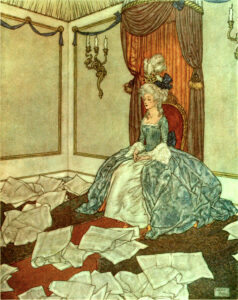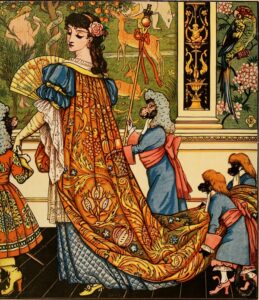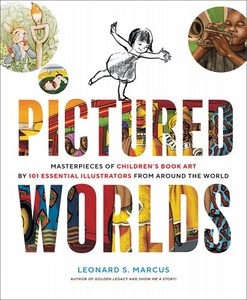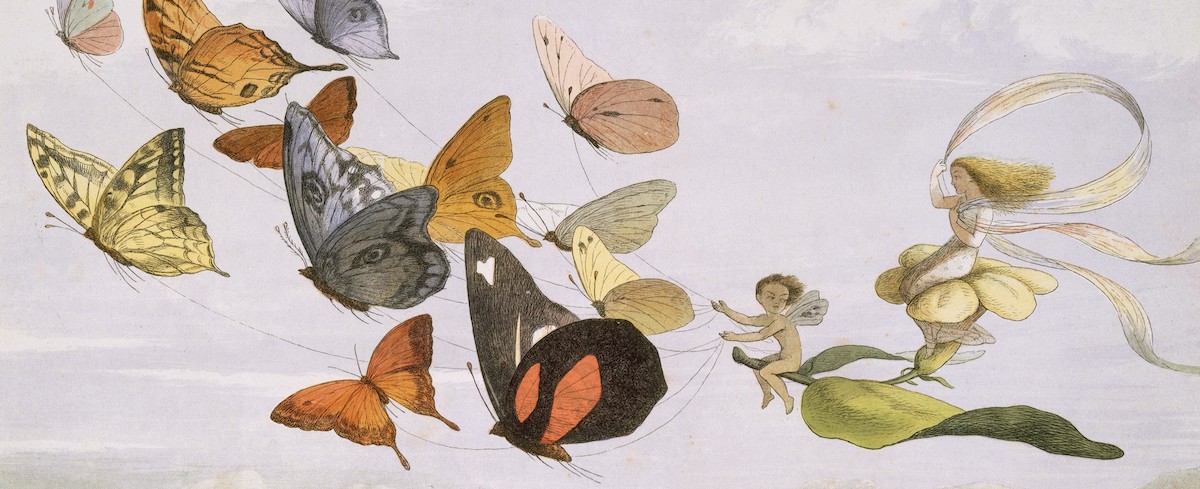The ideal children’s book, John Locke observed, is “easy, pleasant … and suited to [the child’s] Capacity.” Published in London in 1693, Locke’s revolutionary advice book was called Some Thoughts Concerning Education and had something to say about all aspects of a child’s upbringing, starting with the body and ending with the mind. A child psychologist before his time, Locke speculated on the types of books best suited to young people’s capabilities and interests. In doing so, he laid the groundwork for modern-day children’s literature.
Noting, for example, that a child who feels scolded or lectured to is less apt to pay attention than one for whom learning is cast as a game, he argued that a good children’s book is one in which “the Entertainment that [the child] finds might draw him on, and reward his Pains in Reading.”
Locke listed brevity and the addition of illustrations as two other key elements of effective bookmaking for the young. Pictures, he said, were an essential ingredient because, from the child’s perspective, showing always works better than telling.
Widely popular in the West, Locke’s treatise inspired entrepreneurial bookmen like London’s John Newbery—affectionately dubbed “Jack Whirler” by literary lion Samuel Johnson—to specialize in publishing juveniles in the mold of his forward-looking ideas. In doing so, Newbery established the first commercial market for children’s books in the West.
Newbery’s small, trim paperbacks sold briskly to the burgeoning ranks of upwardly striving middle-class English parents and were soon being imitated, or simply pirated, in North America. Half a world away, in the vibrant commercial city of Edo, Japan, a comparable retail trade in akahon, or “red-bound” picture books for young readers, had sprung up independently of developments in Britain but for much the same reasons.
A clear pattern thus emerged that would repeat itself elsewhere around the globe many times over: the recognition of a critical link between literacy and economic and social advancement, and of the illustrated children’s book as a gateway to literacy and a better life. An occasional illustrated book for young readers had appeared in the West before Locke, most notably Johann Amos Comenius’s Orbis Sensualium Pictus
(1658), a picture encyclopedia and language primer that remained in print in one form or another well into the nineteenth century. But it was Locke’s prestigious endorsement that crystallized educated opinion and established the modern children’s book’s norms.
By the time Alice’s Adventures in Wonderland’s first readers were asked to consider, “What is the use of a book without pictures or conversations?” the answer was plain, Locke’s prescient “thoughts” having long since taken their place as literary guideposts for the new literature for young people. To illustrate his Alice fantasies, Charles Dodgson, the Oxford don known to the world as Lewis Carroll, turned to John Tenniel, the lead artist at Victorian England’s most prestigious humor magazine, Punch.
From the mid-nineteenth century onward, pictorial magazines and newspapers in England, Germany, France, the United States, and other countries served as a major recruiting ground for artists with the kinds of skills needed to meet the spiraling demand for juveniles, a knack for narrative and an irreverent spirit chief among them. Before the century was out, the European broadside and periodical press had spawned another lively new genre, the serial strip cartoon, whose cross-generational appeal made it a powerful circulation driver for newspapers on both sides of the Atlantic.
The “funny papers,” it soon became clear, were capable not only of entertaining but also, as in the case of the American Winsor McCay’s Little Nemo in Slumberland, of thrilling readers with the antic verve and originality of their draftsmanship and narrative ambition. Soaring literacy rates and middle-class expectations fed the demand for children’s books across the nineteenth-century industrial world, with London at the center.
As advances in printing technology made color illustration an affordable option, the artistically refined English picture book gathered steam and flourished. Edmund Evans, a noted London printer and proto-book-packager, presided over a popular line of “toy books” created by a stable of accomplished contract artists.
The select group included Walter Crane, Kate Greenaway, and, best of all, Randolph Caldecott, the red-bearded, self-taught illustrator whose jaunty wit and kinetic approach to drawing and composition propelled the picture book into exciting new graphic territory. From then onward, narrative artists were keenly aware of the picture book as a viable art form for dabbling in if not building a solid career.
Beatrix Potter, for one, who grew up in London with framed Caldecott originals on the walls of her parents’ stately Kensington home, made a lifework of her “little books for little hands,” which, starting with The Tale of Peter Rabbit (1902), spread rapidly in translation across Europe and to North America, where they became mainstays of public library collections everywhere.
 Edmund Dulac
Edmund Dulac
In France, two trained academic painters, Louis-Maurice Boutet de Monvel and Edouard Léon Louis Edy-Legrand, seized the cultural moment by creating exquisite pictorial “albums” for children that were immediately hailed as genre touchstones. In Sweden, artists Carl Larsson and Elsa Beskow entered the field under the influence of their friend the visionary philosopher Ellen Key, who argued in The Century of the Child (1900) that the survival of mankind depended on a radical elevation of home life over formal education as the primary formative influence on the citizens of the future.
For turn-of-the-last-century children, elegant gift editions of fairytales and other classic stories came into fashion. England’s Arthur Rackham and his French-born rival Edmund Dulac made their names as masters of the genre, as did Americans, led by Howard Pyle and N. C. Wyeth, and the Russian illustrator Ivan Bilibin, who produced his first deluxe editions based on traditional Russian folk stories in collaboration with the tsar’s own printer and somehow survived the Bolshevik Revolution with his reputation intact.
As the literacy-minded middle class continued to expand, artists experimented with novelty formats that promised the added child appeal of a favorite toy. The unrivaled innovator of the three-dimensional pop-up or movable book was Germany’s Lothar Meggendorfer, a satirical cartoonist by training who, like Randolph Caldecott, approached the illustrated children’s book in a forward-leaning spirit that presaged the coming of the motion picture.
Developments with far-reaching consequences unfolded in the United States around 1900 as social reformers fought to safeguard the well-being of the nation’s children, especially those living in America’s rapidly growing cities. As significant victories were won in the areas of medical care, public education, and child labor regulation, public librarians debated whether they, too, had a role to play in ensuring the welfare of minors.
The ubiquity of digital imagery in everyday life highlighted the unique experiential value of the well-designed picture book that one could hold in hand.By the time industrialist Andrew Carnegie announced his historic gift of a national network of public library buildings, the question had been decided, and the world’s first children’s reading rooms were introduced as a standard feature of the libraries, to be staffed by the world’s first full-time children’s library professionals.
Publishers took note of these changes and hired specialists of their own to meet the needs of the potentially vast new institutional market. Immediately after the First World War, American publishing houses in New York and Boston seized the moment to become the first firms in the world to establish editorial departments dedicated solely to juvenile literature.
It was not by chance that the modest new departments—consisting typically of a single editor and perhaps a secretary—were all staffed by women. The houses’ male top executives patronizingly regarded publishing for children as “women’s work.” As a result, the pioneering professionals who accepted the jobs were often forced to withstand the withering slights of their employers.
These editors, however, found strong allies in their librarian counterparts, and together the two groups worked symbiotically to establish high standards for children’s books and to promote public appreciation of the books as a life-enhancing first experience of literature, art, and culture.
By the mid-1920s, a heady boom time for American commercial and cultural enterprise alike, the librarians and editors had forged an impressive—and, as it turned out, durable—system for the achievement of their goals, an institutional structure that included Children’s Book Week as an annual national publicity campaign, The Horn Book magazine as the world’s first children’s literature review journal, and the John Newbery Medal as the first literary prize awarded to a writer of books for young readers.
European and, later, Asian publishers adopted aspects of the American model, but the zealous sense of purpose that propelled twentieth-century children’s book publishing forward took other forms as well. In the Soviet Union after the 1917 Revolution, the central government embraced children’s literature as an essential tool of nation building and sponsored the publication of illustrated books for the young designed to engage their interest in the collective dream of the new Soviet society.
Like the era’s graphically striking posters, picture books illustrated by Vladimir Lebedev, Mikhail Tsekhanoveskii, and others telegraphed inspirational messages in a spirited visual shorthand that not only helped shape the perceptions of millions of Soviet children but also fueled the experimental efforts of picture book artists in Paris and New York.
 Walter Crane
Walter Crane
Building on the empirical observations of John Locke, Friedrich Fröbel, and others, early-twentieth-century psychologists systematically charted the stages of childhood development, and in the United States, progressive educators searched for ways to translate the psychologists’ discoveries into more effective, child-centered approaches to teaching and learning.
At New York’s Bureau of Educational Experiments (later the Bank Street College of Education), founder Lucy Sprague Mitchell studied the natural arc of language development and its implications for books for children as young as two. Soon Mitchell’s research findings put her squarely at odds with the views of America’s leading librarians.
For young children, the librarians favored aesthetically refined picture books printed on heavy stock and with elegant cloth bindings, strong narrative art, and “once upon a time” texts meant to transport the child from the crassly commercial modern-day world to more fanciful realms where their imaginations might freely grow and flourish.
Mitchell dismissed the librarians’ view as Romantic sentiment, arguing that children were in fact little empiricists and sensory learners who longed for books about the “here and now” urban world they knew from experience. Mitchell also believed that young children were too often treated at library story hours as passive observers, and that it was more natural and beneficial for them to be encouraged to speak up, make noise, and participate as full collaborators in the reading and performance of books.
For this reason, Mitchell favored picture book texts with a call-and-response or gamelike element and illustrations that depicted everyday subjects in a graphic, semiabstract manner that left more to the imagination than did a literal-minded, realist approach.
By the early 2000s, the most spectacular case of a newfound national commitment to the genre was that of China.Not satisfied with theorizing, she groomed a corps of young writers, including Margaret Wise Brown and Ruth Krauss, and illustrators, including Leonard Weisgard and Clement Hurd, to put her insights into practice, and even persuaded a Bank Street nursery school parent to launch a publishing company dedicated to bringing their work to the marketplace. The clash of values represented by Mitchell’s and the librarians’ opposing visions resulted in years of bitter feuding and acrimonious debate and, when cooler heads finally prevailed, in a significant expansion of the picture book’s expressive possibilities.
The late Victorian illustrators Walter Crane, Kate Greenaway, and Randolph Caldecott all had their eyes opened wide by the arrival in the West of Japanese ukiyo-e prints by Hokusai, Hiroshige, and others, which showed them new ways to simplify an image, balance a composition, exploit white space, and integrate decorative elements within a scene. In fact, where illustrated children’s literature was concerned, Japan’s mid-nineteenth-century opening to the West resulted in a fruitful two-way flow of cultural influences.
Japan’s educational system and publishing industry both underwent systemic reorganizations based on Western models, and with the advent of a postal service and periodical publishing, a vibrant trade in Western-style illustrated children’s magazines developed in Japan that culminated in the launch in 1922 of the artistically daring Kodomo no kuni (Children’s Land), with illustrations that represented a fertile blend of traditional Japanese and European modernist graphic styles.
In 1930s Japan, military glory and imperial conquest became the dominant themes of young people’s illustrated books and magazines. In the United States, by contrast, picture books like Marjorie Flack’s Angus and the Ducks (1930) and Virginia Lee Burton’s Mike Mulligan and His Steam Shovel (1939) presented an insular and resolutely idyllic view of childhood.
The darkening world situation prompted European illustrators such as H. A. Rey, Feodor Rojankovsky, and Tibor Gergely to flee to the safe haven of American shores—and to the creative cauldron that was mid-century Manhattan. The talent and energy these artists brought to their adopted homeland would greatly enrich the American picture book for decades to come.
As the American picture book gathered momentum throughout the years of the Great Depression, librarians decided the time had come for a companion prize to the Newbery Medal for distinguished work by an illustrator. In 1938, the Randolph Caldecott Medal became the world’s first award honoring children’s book art. As a public statement about library standards, it arrived none too soon, just as the new ten-cent comic books were captivating young readers by the millions with their action-packed (or, as critics argued, crudely sub-literary and escapist) fare.
Most children could afford to purchase comic books with their own pocket money and often did so when their adult caretakers were not looking—a clandestine arrangement that only added to the comics’ allure. The line that librarians drew between high-culture picture books and low-culture comics would prove to be a largely American phenomenon, as Tintin, Astérix, and Moomin cartoons in Europe and manga in Japan all enjoyed broadly based cultural approval as well as commercial success on their home grounds.
Another major challenge to the librarians’ authority as literary gatekeepers came in 1942 with the launch of Little Golden Books, a line of colorful, trim, low-budget picture books that dispensed with some of the aesthetic frills favored by the library world in order to make picture books affordable for just about everyone. Little Golden Books were marketed directly to parents at drugstores, five-and-dimes, and supermarkets at the bargain price of 25 cents each, a revolutionary approach that for the first time made it possible for families of modest means to create home libraries for their children even if they lived far from the nearest big-city bookstore.
By 2015, the never-very-robust demand for electronic picture books all but evaporated in the United States.After the Second World War, American juvenile publishing prospered in parallel with the rising birth rate, and idealistic editors in the United States and Europe searched for tangible ways to channel their efforts on behalf of children and their books into a force for world peace. In 1949, with support from the Western publishing community, a German Jewish journalist named Jella Lepman spearheaded the creation of the International Youth Library in Munich as a central repository for the world’s children’s literature, where visitors from afar might come together to discuss innovative ways to foster cross-cultural awareness through books.
In 1953, Lepman made a second major contribution as founder of the International Board on Books for Young People (IBBY), a nonprofit organization designed, in effect, to bring the International Youth Library’s work to the rest of the world through a program of conferences, publications, and awards.
Then in 1964, a third experiment in internationalist activism would prove to be perhaps the most effective one of all. In that year, the Bologna Children’s Book Fair convened for the first time as an annual international rights fair aimed at facilitating the commercial flow of children’s books across national and cultural borders.
Publishers from England, France, and Italy formed the core of the first Bologna gathering. The United States soon joined as an enthusiastic participant, as did Japan, whose publishers were eager to establish their place as cultural partners with their counterparts among the Western industrialized nations.
After the war, American picture books became popular in Japan, at first in makeshift translations created by participants in the informal system of bunko, or home libraries, organized by volunteer mothers for the benefit of their local communities.
As the Japanese publishing industry rapidly reconstituted itself and resumed normal operations, Japanese-language editions of American picture books such as Curious George and Make Way for Ducklings and of British imports such as The Tale of Peter Rabbit became mainstays of the publishers’ lists and cherished symbols of renewed friendship with the West.
In the years that followed, American picture books not only influenced the direction taken by postwar Japanese writers and illustrators, but also set in motion a decades-long chain of influence that played an important role in the development of picture-book-making in Taiwan, South Korea, and, by the turn of the new century, China.
The postwar years also saw the rise to prominence of a new generation of graphic artists who believed that their work, too, had relevance for building a more harmonious and peaceful world. In Italy, Bruno Munari designed a set of nine unconventional picture books with ingenious paper-engineered, gamelike, three- dimensional novelty effects that blurred the boundary between book, toy, and sculpture and challenged children to approach life with a more open mind.
American designers Leo Lionni, Paul Rand, and Eric Carle transferred their facility for crafting poster, logo, and advertising images to picture books that made telling use of white space, boldly simplified forms, and brilliant color contrasts to communicate with children in a distilled pictorial language that was at once artful and accessible. Their pared-down, semiabstract approach would inspire countless imitators in the decades to come and prove to be of particular value as demand rose on the part of ambitious, college-educated parents of the 1970s and after for books for children in the very first years of life.
The cultural ferment of the 1960s expressed itself in children’s books through a decisive turning-away from traditional narratives about idealized, morally innocent children in favor of more nuanced stories about real children in all their psychological and moral complexity. The quintessential expression of this altered perspective was Maurice Sendak’s Where the Wild Things Are (1963), which, by reassuring young children that their powerful urges and inchoate emotions were a natural part of living, belatedly ushered the picture book into the Freudian age.
As world markets grew more closely linked from the 1970s onward, picture books by the United States’ Maurice Sendak and Eric Carle, England’s John Burningham and Helen Oxenbury, Dick Bruna of the Netherlands, Květa Pacovská of the Czech Republic, and others spread in translation around the globe.
So, too, did the dazzlingly original work of the Japanese artist known in the West as Mitsumasa Anno, whose wordless picture books represented an adroit fusion of Eastern and Western imagery and cultural values. At the same time, areas of the world not previously known for producing picture books of their own began generating their first such books in a reprise of the pattern previously played out in Europe, North America, and Japan.
During the 1970s, this occurred in nations as culturally different from one another as Australia, Ghana, and Venezuela—all former colonies with a growing middle class for whom the production of homegrown books represented a momentous milestone in their national coming-of-age.
By the early 2000s, the most spectacular case of a newfound national commitment to the genre was that of China, a 5,000-year-old cultural megalith with a dour, no-nonsense educational tradition that in the past had left scant room for imaginative children’s literature in the Western sense of the term. For the Chinese people, the twentieth century had largely been a time of convulsive social and political upheaval.
The opening to Western cultural influences that followed in the wake of the Cultural Revolution found concrete expression in the determination of publishers, artists, and writers to provide the next generation of children with a more nurturing formative environment than had been possible during the radically disruptive final years of the Mao regime. As China’s middle class underwent dramatic expansion and the nation’s population passed the 1.4 billion mark, access to Western-style picture books came to be viewed as one of the keys to achieving this objective.
By 2015, Chinese publishers had acquired rights to more than two thousand Western children’s books, including all of the major American award winners, and were looking ahead to a not-too-distant future in which their own picture book artists and writers might assume a prominent role on the world stage.
Five years later, even as China’s central government once again seemed intent on limiting the scope of Western cultural influence on its children, privately owned Chinese publishing companies were strengthening their ties to the Western children’s book market, as exemplified by Trustbridge Global Media’s acquisition of New York-based Holiday House, London-based Walker Books, and Walker’s US outpost, Candlewick Press; and Thinkingdom Media Group’s purchase of Europe’s minedition and launch of a US editorial base called Astra Publishing House.
The digital revolution of the early 2000s presented illustrators with a new set of tools with which to paint and draw and spawned a new art form: the app, which combined aspects of animation and the illustrated book. The internet also allowed illustrators to showcase their work to a global market, a once-unimaginable opportunity that, in combination with the ease of electronically transmitting digital art to any locale, resulted in a sharp rise in the number of picture books created by collaborators working across national borders and at great distances from one another.
The new technologies, however, did not, as some had confidently predicted, render the traditionally printed picture book obsolete, but seemed rather to do just the opposite. For many in the children’s book world, the ubiquity of digital imagery in everyday life highlighted the unique experiential value of the well-designed picture book that one could hold in hand as the centerpiece of an intimate encounter between an engaged caregiver and a child.
By 2015, the never-very-robust demand for electronic picture books all but evaporated in the United States, and publishers found themselves redoubling their efforts to fashion picture books that were alluring material objects. All this was happening as a generation of seasoned editorial illustrators, having seen demand for their work dwindle in the shrinking newspaper and magazine market, migrated to children’s book illustration as a viable alternative outlet for their creativity.
Synchronously, the audience for picture books and illustrated narratives generally was becoming more fluid as experimental zine and web-based comics artists, long accustomed to operating on the noncommercial fringe, suddenly found themselves embraced by mainstream publishers eager to build the graphic novel into a cross-generational phenomenon. Some of these artists went on to discover the picture book as well, bringing formal comics elements and, often, a hipster maverick sensibility to the genre that further enriched its narrative vocabulary.
__________________________________

Excerpt from the new book PICTURED WORLDS: Masterpieces of Children’s Book Art by 101 Essential Illustrators from Around the World by Leonard Marcus published by Abrams. Text copyright © 2023 Leonard Marcus.



